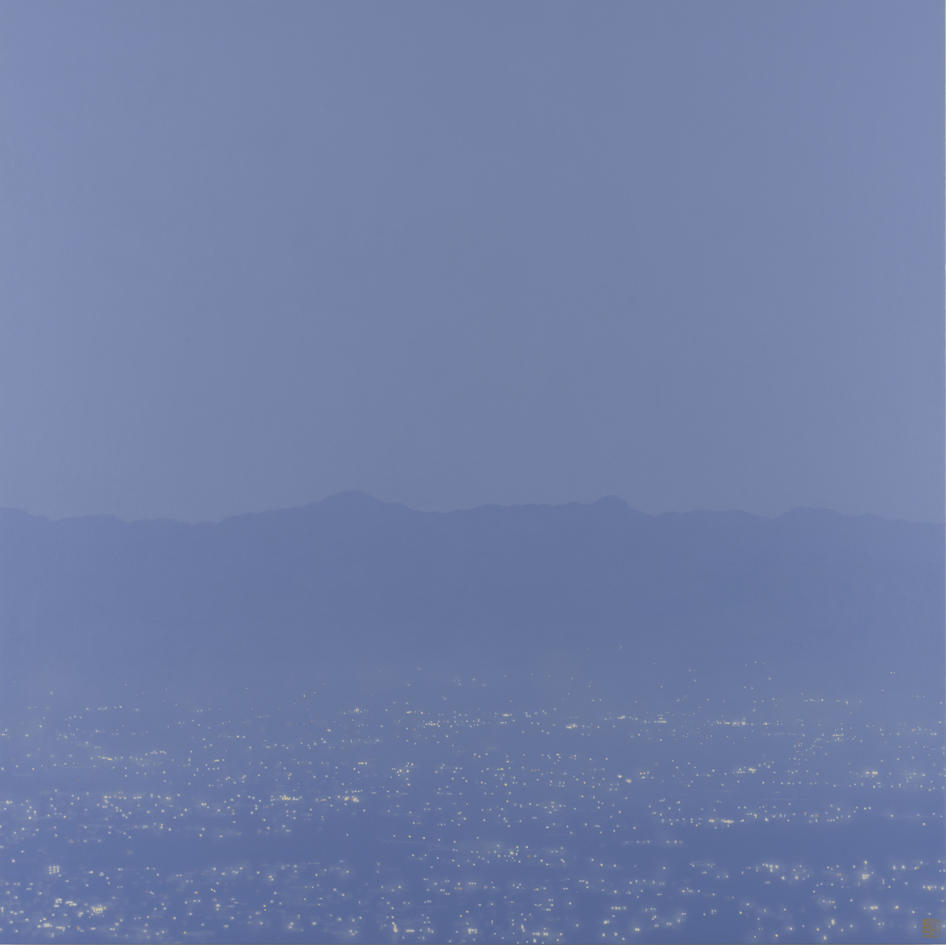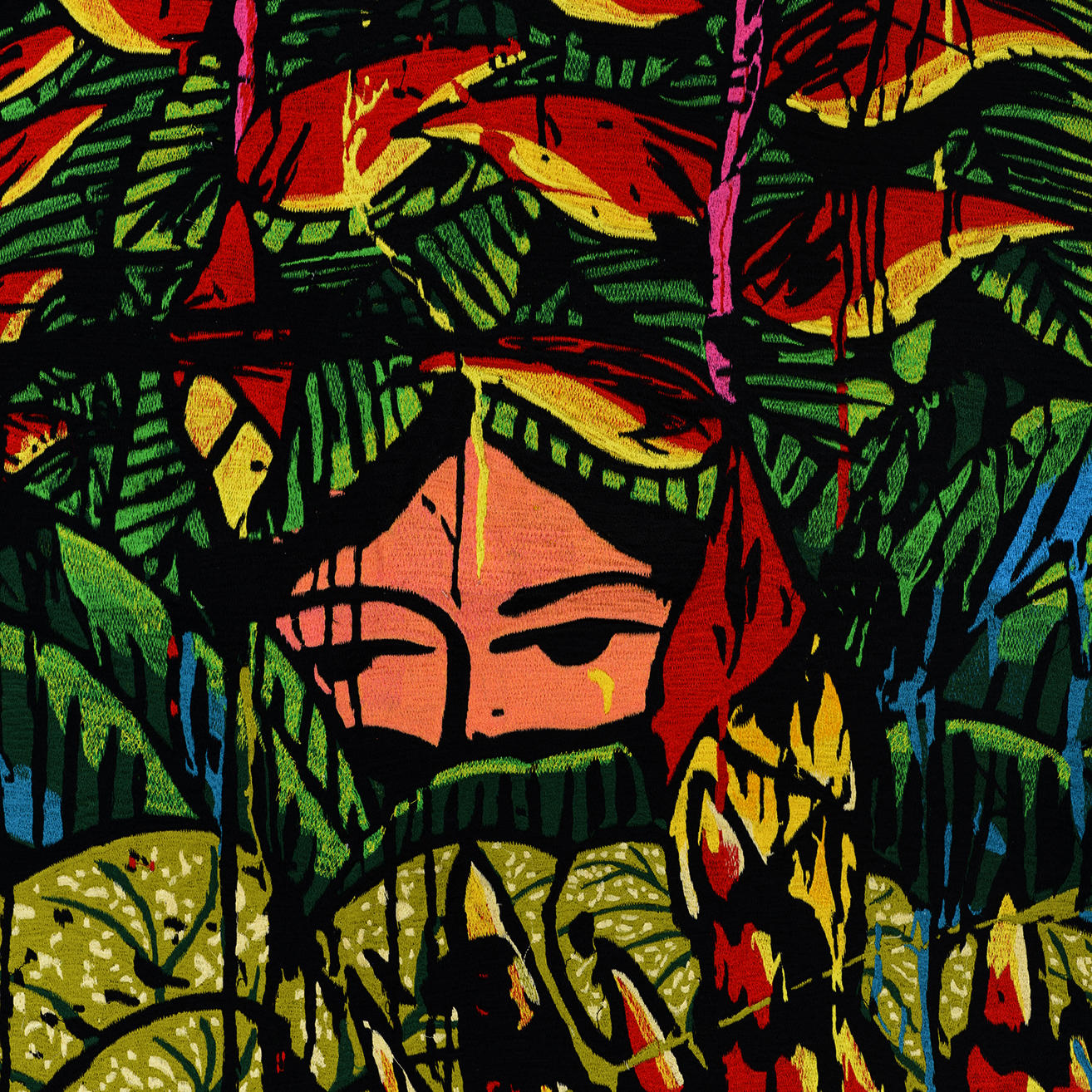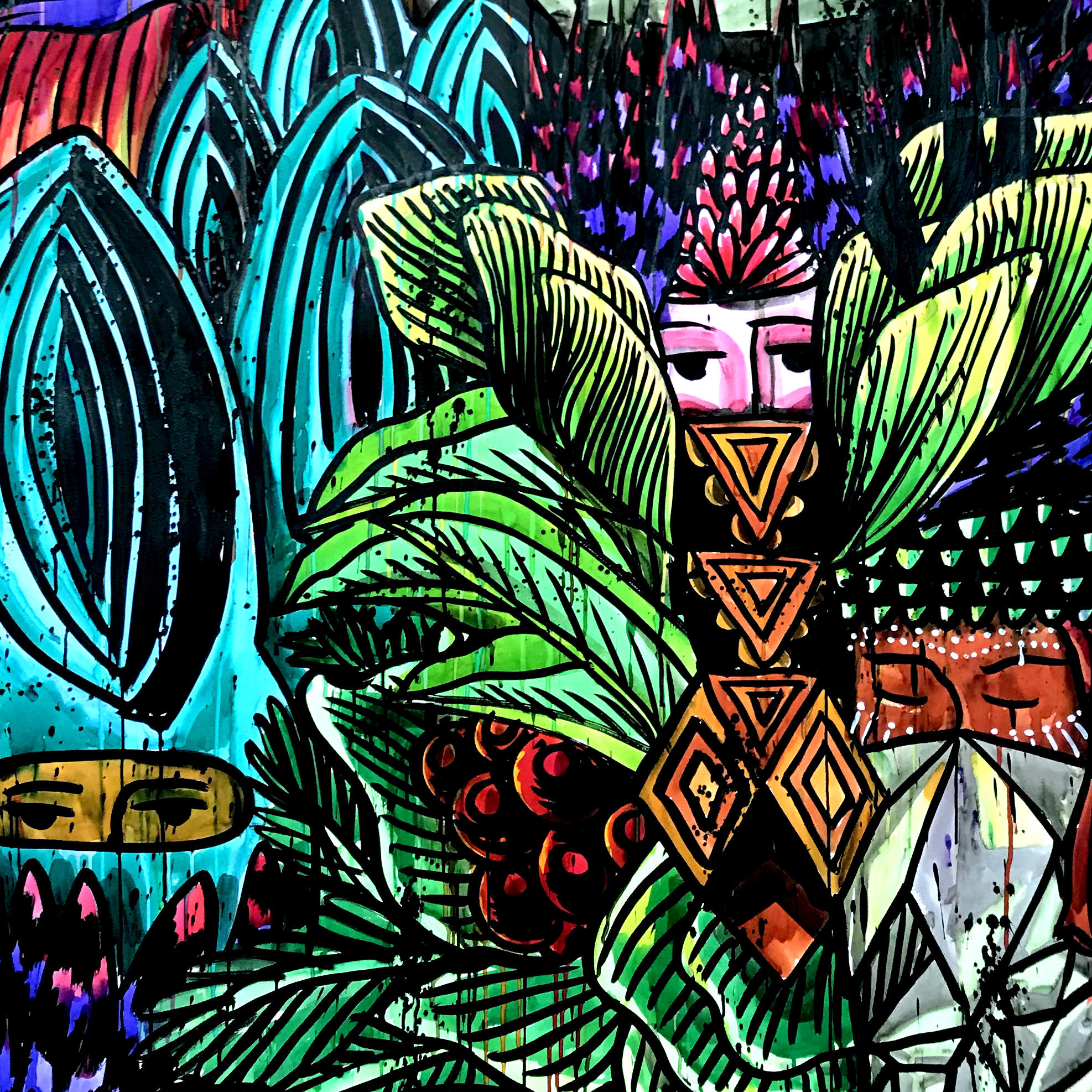Project
Dialogue: work commentary by Eko Nugroho
Gallery
2019. Oct. 4 (Fri) - Nov. 3 (Sun)
Eko Nugroho, treating social issues as motif but showing something humorous visual. Strong outlines and intense colors of his works greatly attract the interest of audiences.
In his solo show at Art Front Gallery, which is organized in co-ordination with the inauguration of the autumn iteration of the Setouchi Triennale 2019, Nugroho responds to the theme, the present and pressing issue of immigration and national borders. This time we had Nugroho talk about the concept of this solos show, work commentary, and some interesting episodes.
| Date | 2019. Oct. 4 (Fri) - Nov. 3 (Sun) |
|---|---|
| Hours | 11:00 - 19:00 (closed on Mondays and Tuesdays) |
| - | Eko Nugroho’s solo exhibition: Nowhere Is My Destination |
| opening time |
AFG:
In this solo show and work of Setouchi, you explores issues concerning borders, migrations and the identities of those who were forced to leave their countries behind due to wars and oppression. You describe the irrational reality as “a wall” which still surrounds refugees. When I heard this concept at first time, the very concrete image popped out of my head: the wall construction along Mexico–US border. However, when we faced these works, we just realized this keyword “wall” means much more comprehensive, psychological issues. Could you elaborate on this “wall” once again?
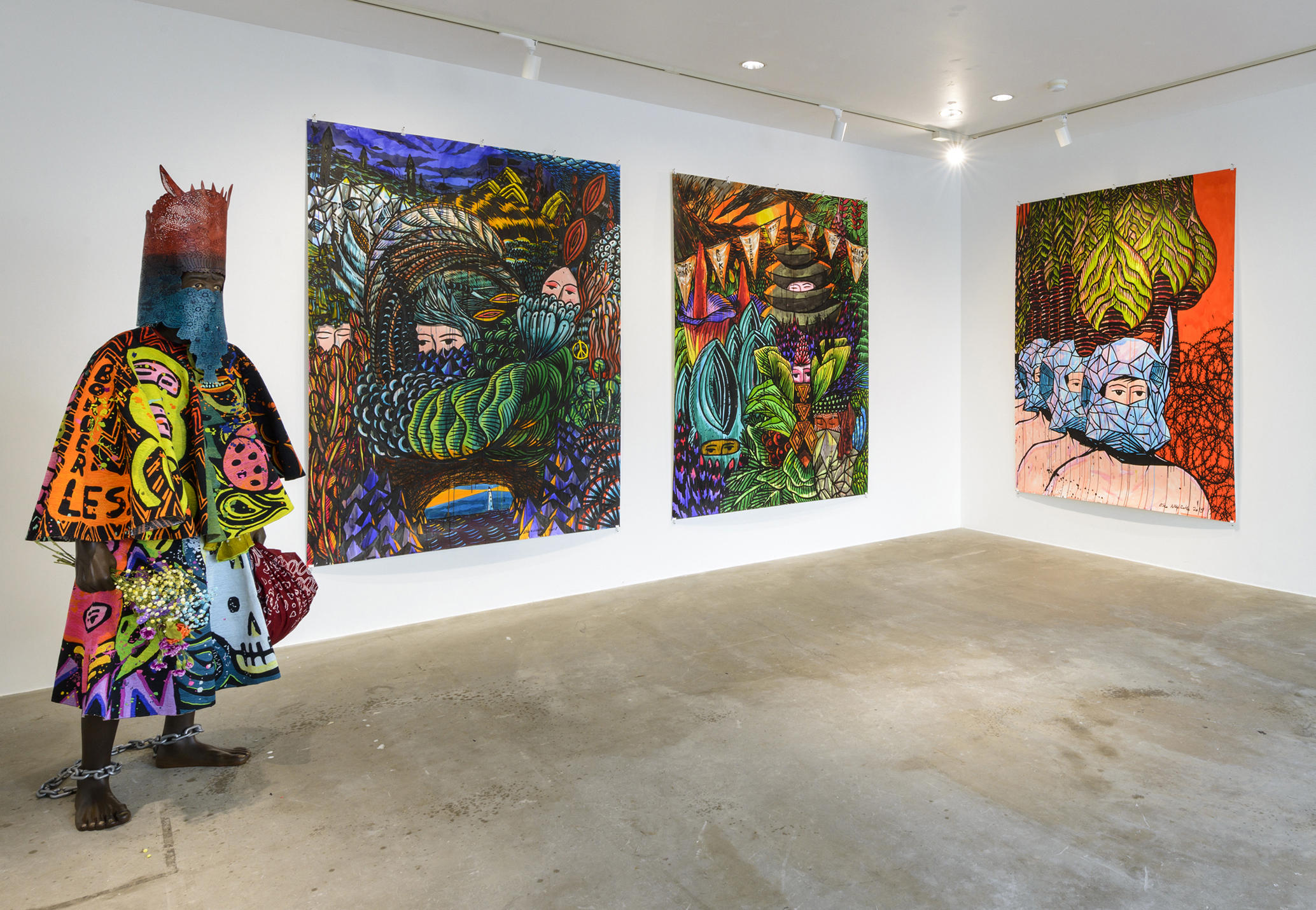
installation view at Art Front Gallery
Nugroho:
I will explain the connection of Triennale and of exhibition here. I have an interest in border itself, how the people is divided between the walls in a way also the wall is already existing in the brain, even if we have democracy and freedom. We always try to define the border, this is the idea. That is why I put installation in a beautiful old house, where there is already a wall, but I made another wall inside the house.
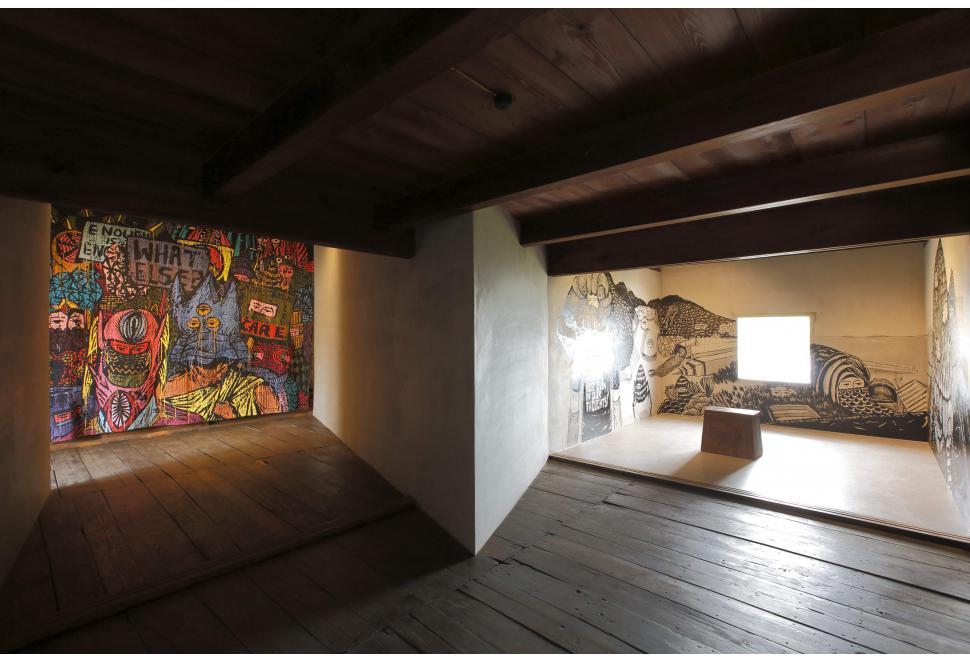
installation view at Art Setouchi 2019, Ibukijima-island
Nugroho:
In the area Iwata, I heard that the emotion of the people living there is different from ours, that is, they are living in the beautiful island, but the land is empty, and we simply feel that there is solid, which is also "a wall" and this is already a found in this project, the loneliness and other new world. In a way I took this energy must be expressing our where they are living alone. It is a little complicated but it is like a detection and you can see the beautiful site just concrete wall. Then I took this loneliness as an idea to set my painting on this wall, I think, people have this loneliness but that brought me lot of fantasy, of happenings in my mind. This is what I have feeling in these people.

Eko Nugroho "What I Plant Grows Wilder Than What You Plant", 280x150cm, Embroidery, 2019
< About embroidery work “What I Plant Grows Wilder Than What You Plant” >
AFG:
It is quite impressive to see vivid colors, strong outlines, textile pattern-like description, and people without expression hiding their faces. It must take plenty of time to make, how did you make it? You often reference to the Indonesian tradition as well as contemporary pop culture. Did any Indonesian tradition, for example Batik, inspired this work?

detail of "What I Plant Grows Wilder Than What You Plant"
Nugroho:
This work was started in 2007 as a community project, because the craftsman were eliminated by the introduction of computer machinery, they lost their shop. I asked the man always working for the shop, they were to go back to their village to become a farmer or a taxi driver, and then I asked them to join me for the project. They said they want to try, so I bought sowing machines to represent my painting in embroidery. The image is based on my painting, and we copy the basic as much as possible though it is not always possible to realize exactly the same color. Mostly it takes one month to finish, but sometimes it takes longer to wait the threads to come.

Eko Nugroho "Nowhere is My Destination", 182x88x78cm, mixed media, 2019
< About sculpture ” Nowhere is My Destination” >
AFG:
The sculptural work from which the title of the exhibition is drawn. This iconic figure covering its origin with a mask and holding a knapsack in one hand while chained in leg-irons would confront viewers with the clash between their thirst for freedom and the harsh reality they would have to face. On the other hand, despite of his serious fate, a bit funny to see he wears high quality poncho and mask. You said to me that actually there is a model of this statue, didn’t you?

detail of "Nowhere is My Destination"
Nugroho:
Yes I did, this statue has a model, a man named Sugicho. He is always working as a farmer to sell rice. He tries to sell a lot using pesticide at his own expense, because of the deterioration of the soil, he can produce less and less, in a way three times a year in Indonesia. One day he started to talk about politics: democracy is becoming chaotic in our society if the people celebrate democracy. It is funny that Sugicho is talking about the politics, welcoming the people saying that “please, come in our house to have a drink, to discuss the democracy”. I put his feeling in this sculpture. People coming with their own culture and every culture has its own.

detail of "Nowhere is My Destination"
AFG:
Please explain about the mask. Most people on your works as motif wear the masks, don't they? Besides, I can’t help touching the topic about inexpressive faces of the people on your paintings. While we talked during installing this exhibition, you told me the episode of the person who has poker face, which describes the information we receive has been increasing but we have being reduced communicating face to face these days. It seems for me that you are describing people in Tokyo. Personally, these poker faces make me imagine the people who got on a commuter train of Tokyo, looking that nothing thought about and just gazing smartphones until arrival.

detail of Eko Nugroho "Nowhere to Nowhere" (200x150cm, ecoline on paper, 2019)
Nugroho:
The leather mask on statue is actually closely connected with silhouette papette to show the motif on the one hand, but also to show the craftsmanship of cow leather, The border between the people is represented here as "Make Humanism great again". (laugh) People nowadays are understanding each other by internet, and they are less and less talking or listening directly, which is the idea of mask depicted here. It is like watching "emptiness", just as you mentioned, just watching without meaning. I created these painting a year ago, these colors referring to different "colors" in democracy.

installation view of mural "Nowhere is My Destination" at Art Front Gallery
< About the mural >
AFG:
This huge mural, specially made for this solo show, but you made it in only 2 days. I was surprise to see that you never draw the draft on this. While the first room has plenty of colors, this mural is used minimum monochrome. The mural on the left sidewall, we can recognize some Japanese stuff are painted, I want to hear your episode on this. It’s also interesting to see two people hold the Japanese meals on the tray. Meals always matters especially when travelling abroad, do you reflect such kind of interest to this work?
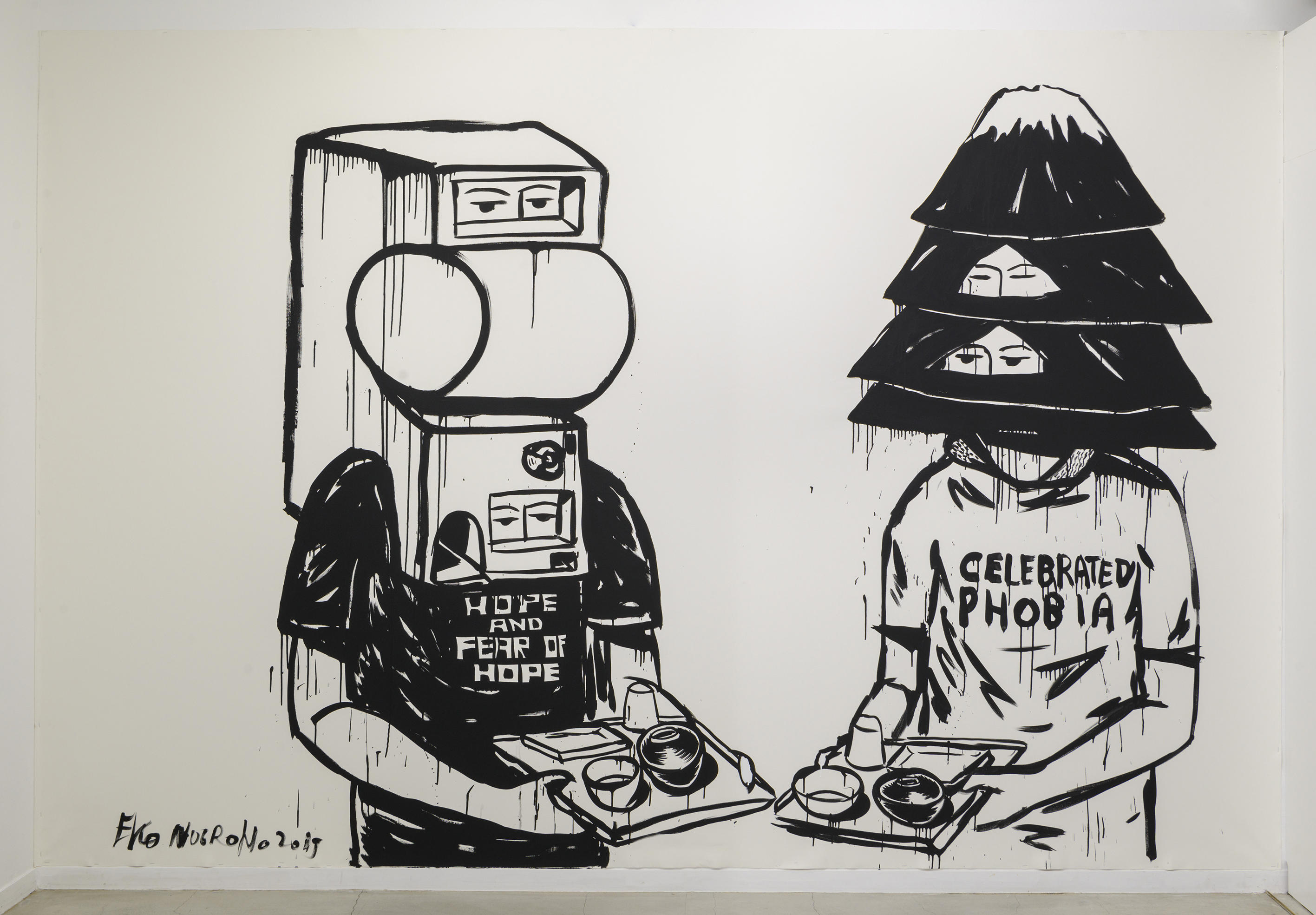
installation view of mural "Nowhere is My Destination" at Art Front Gallery
Nugroho:
I like painting outside on the given wall, since I take energy in different place such as Setouchi. I came to Japan many times, and this time tried to explore the scenery of everyday lives. For example, “gacha-gacha” is interesting since they are hoping the luck of that day only to get small figure. The Mt. Fuji symbolizes the Japanese culture to keep his identity. We the Indonesian collects many cultures from different countries, but nowadays people are getting fear or angry to become "phobia" against being frequently celebrated.
Also, in Japan they are always carrying trays where everything is put together while in Indonesia people have plates and drink in the other hand. It is like a paradise for me, the landscape we find around myself.
Artists
Related News

![[Art Fair] ART SG 2025 in Singapore](https://artfrontgallery.com/whatsnew/assets_c/2024/12/Eko%20Nugroho_bubunn-thumb-961x961-12427.jpg)





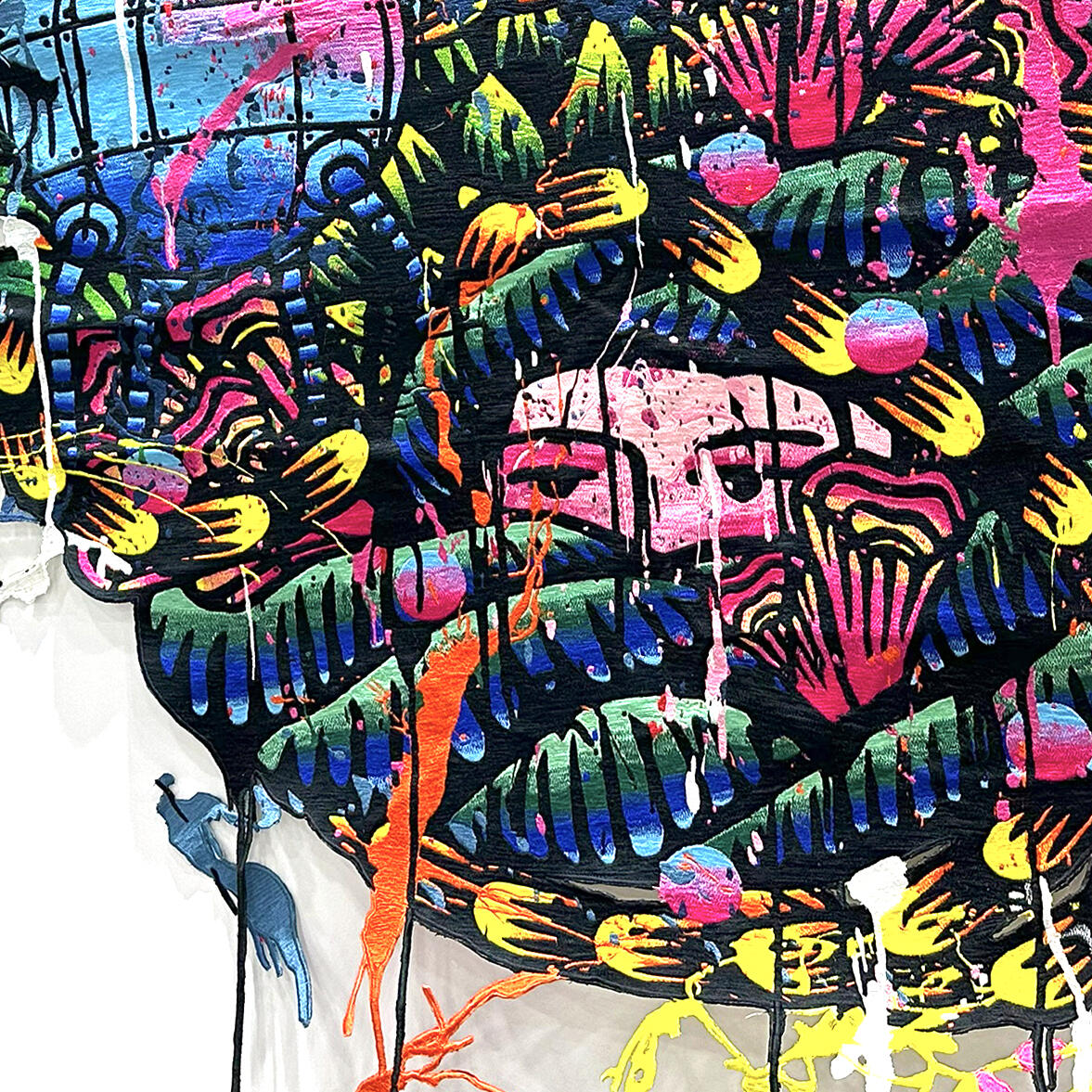
![[ART FAIR] Art Fair Asia Fukuoka 2023, Japan](https://artfrontgallery.com/whatsnew/assets_c/2023/09/afafa-thumb-1712x1712-11458.jpg)


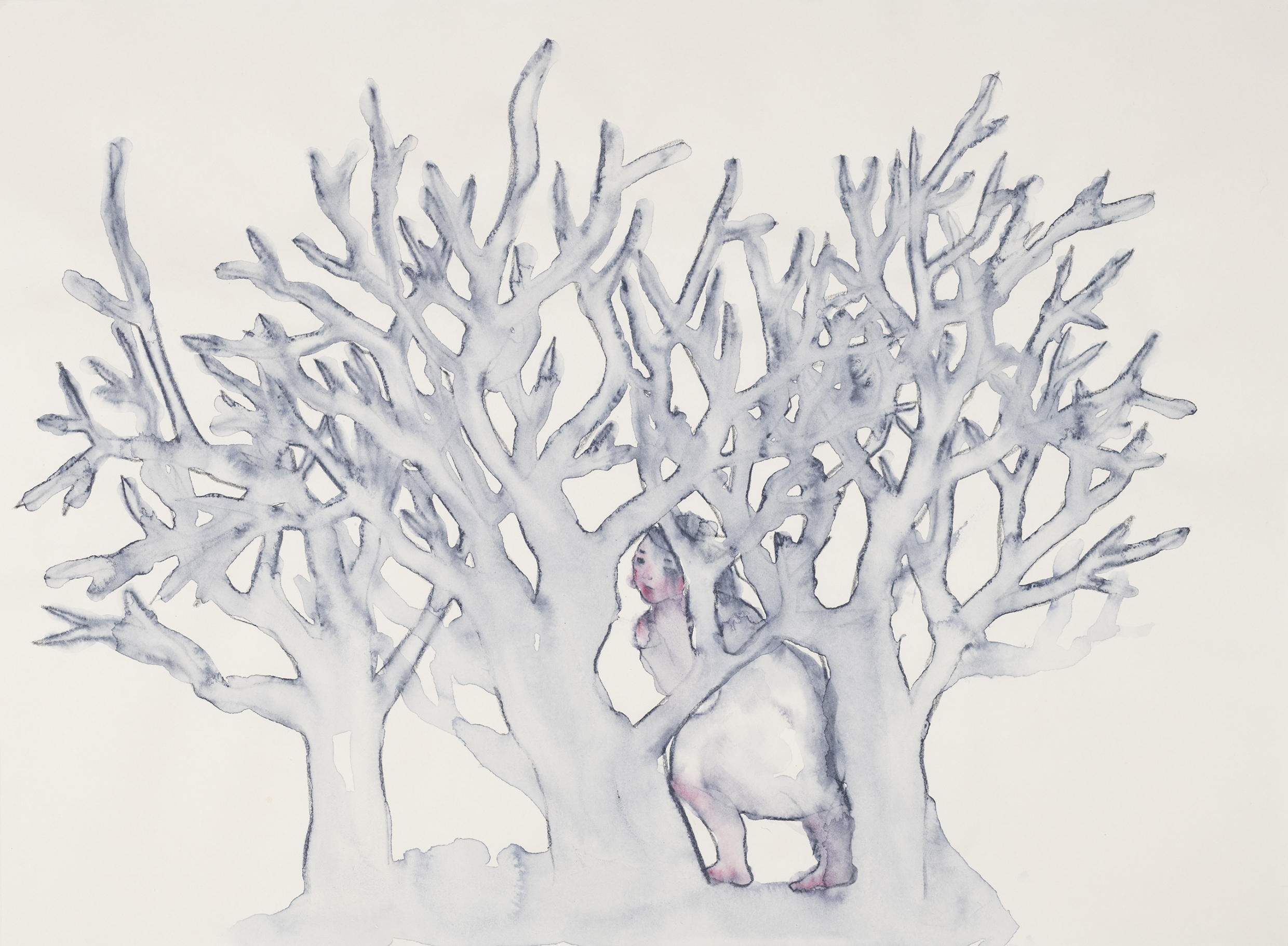
![[Oct. 9] Art Front Selection 2020 autumn : Temporarily closed](https://artfrontgallery.com/whatsnew/assets_c/2020/10/3ebd832ad43ca0ffa8a63682bb49b2fe5258a439-thumb-2444x2444-8076.jpg)

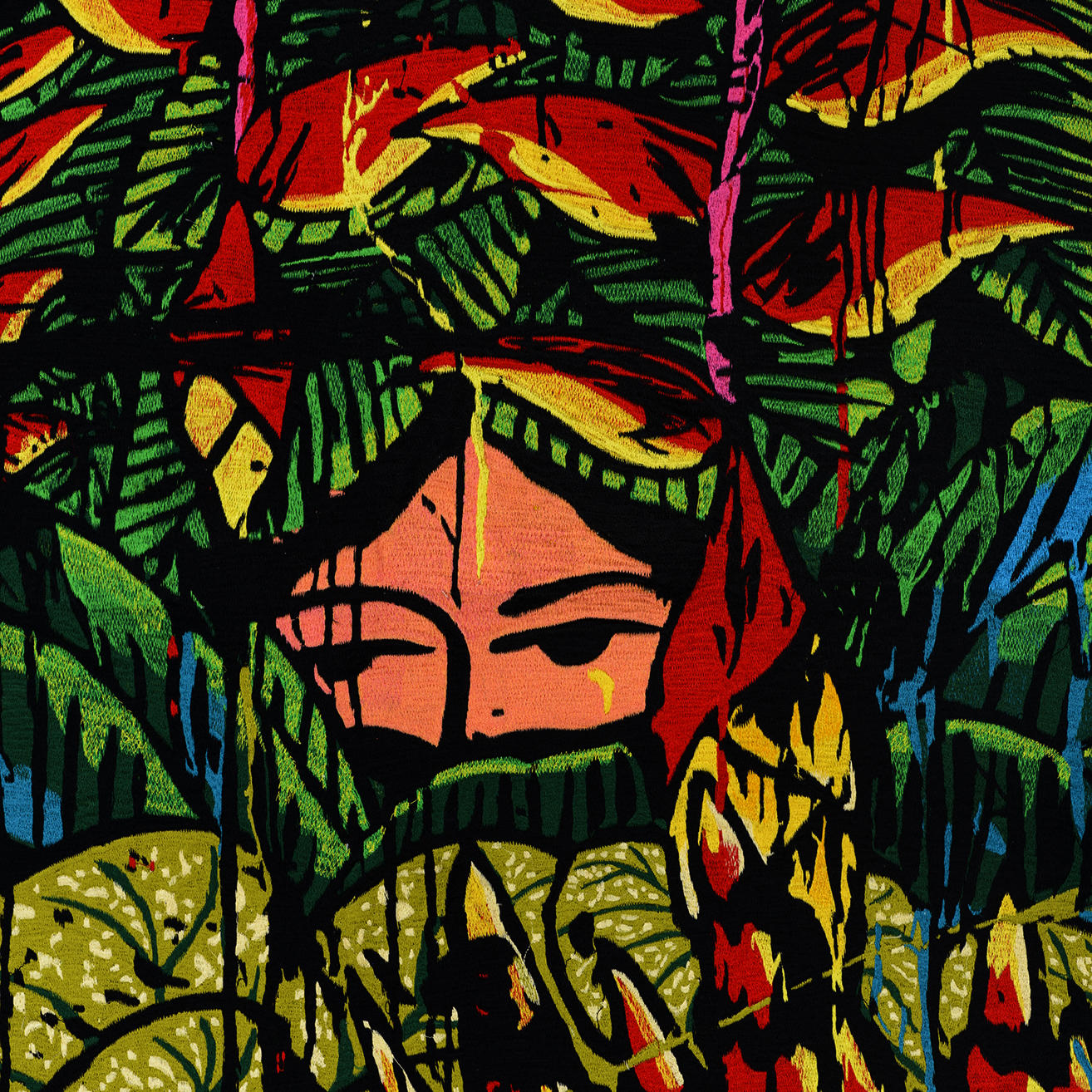
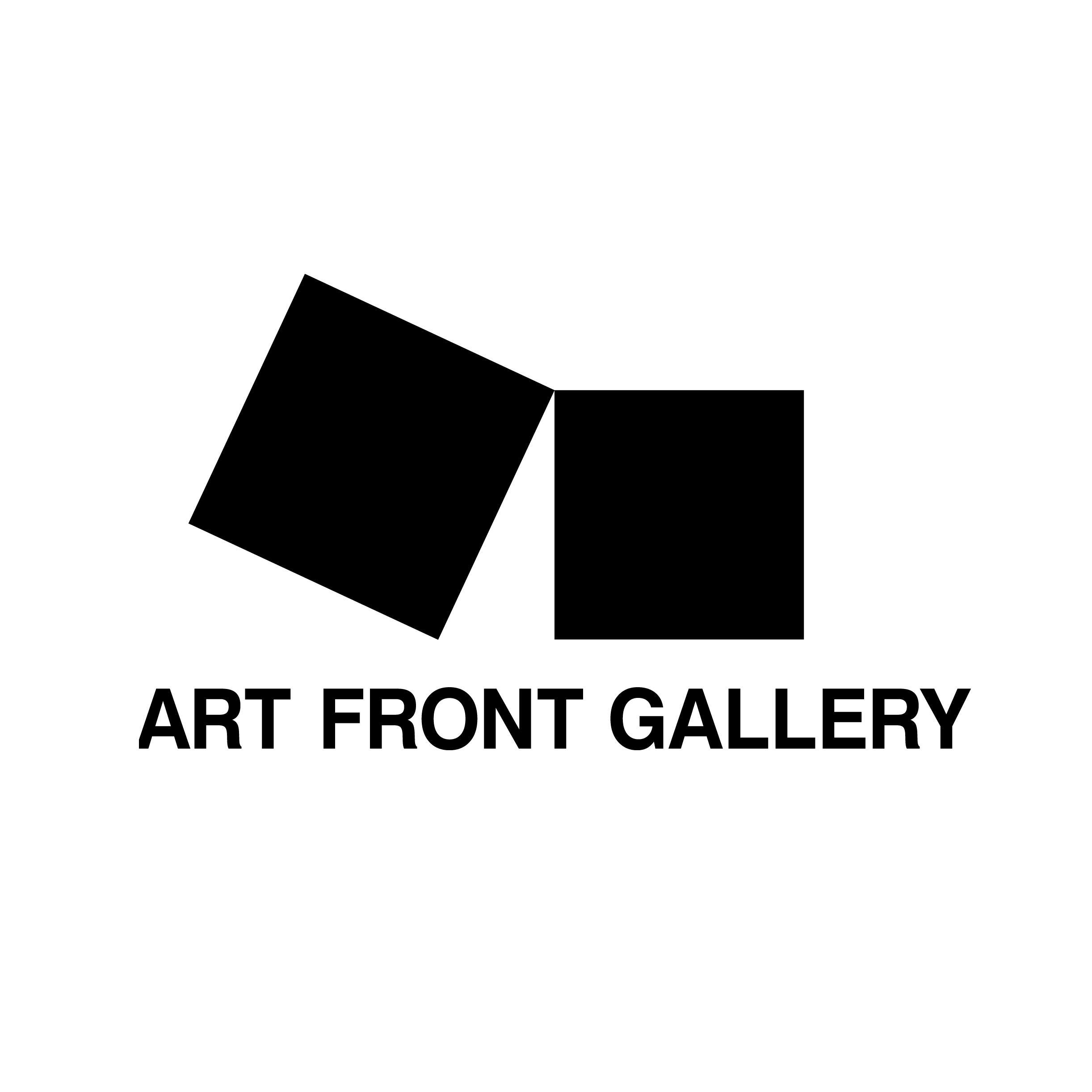

Related Exhibition




